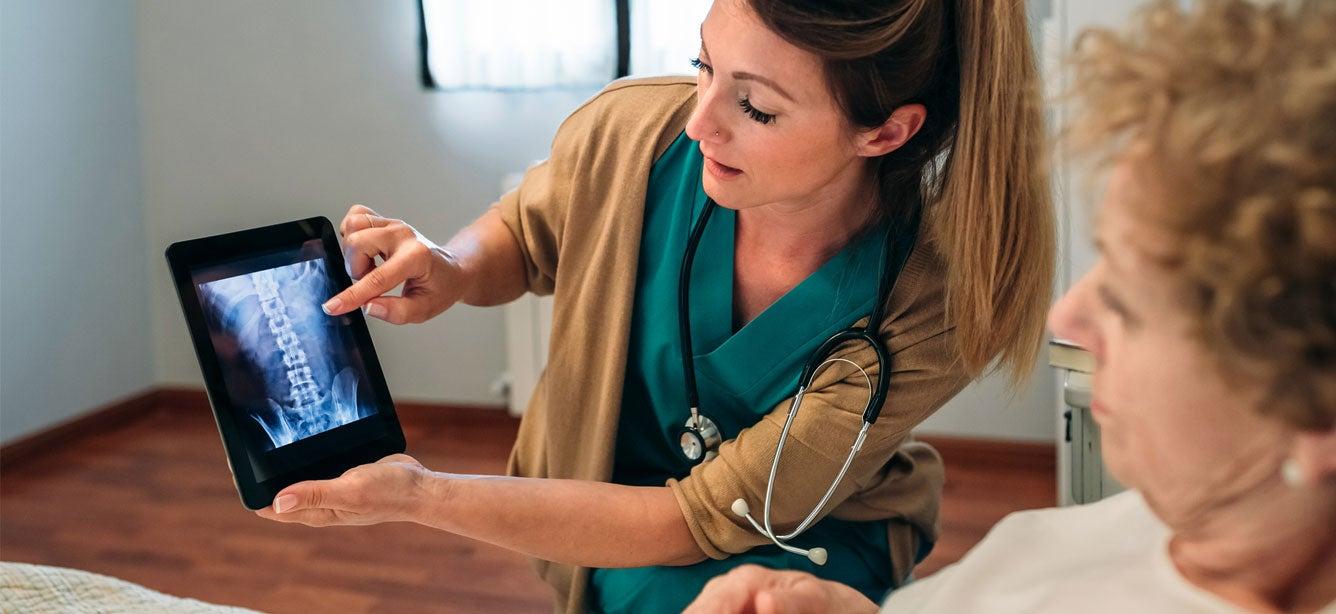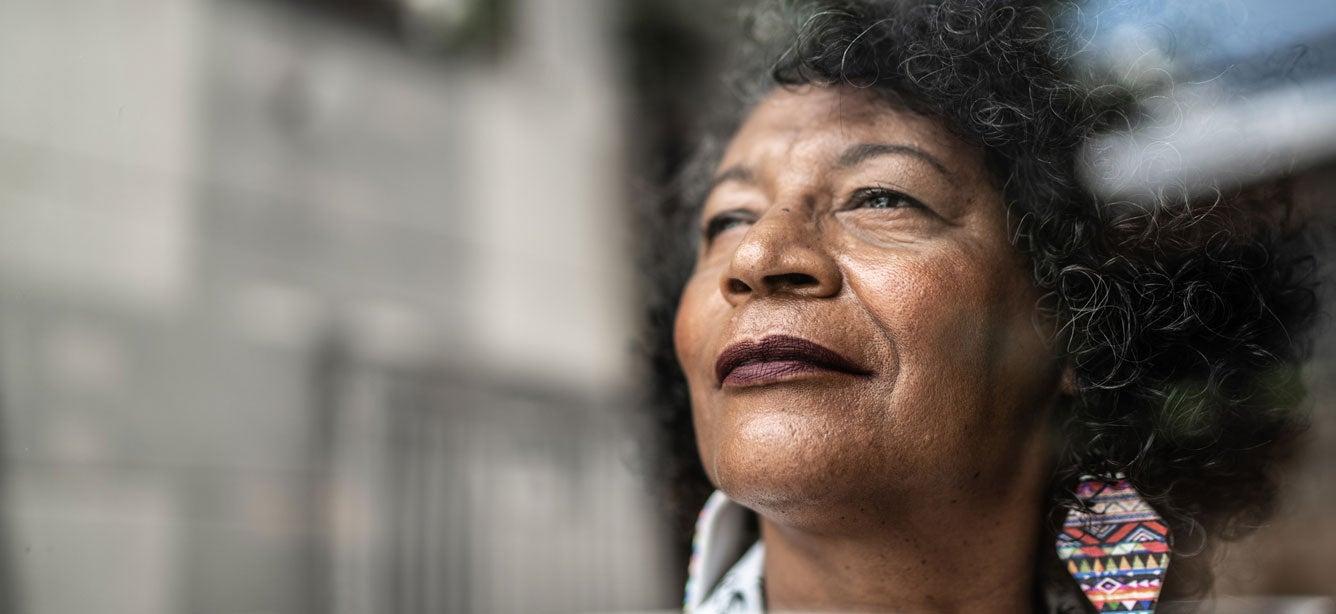
Related Topics
When we're young and healthy, we typically don't think too much about our bones. We take for granted that they help us sit, stand, bend, walk, dance, and experience all life has to offer. As we age, however, the health of our bones plays a much more prominent role in our well-being. One key aspect of our bone health is bone density.
What is bone density—and why is it so important?
Bone density is a measurement of the amount of minerals present in a specific area of bone. These minerals, primarily calcium and phosphorous, make up 65% of bone tissue and are what give bone its hardness and rigidity. Other terms used for bone density are bone mineral density (BMD) and bone mass.
Bone density is an important indicator of how likely bones are to break. It’s also valuable in identifying osteopenia and osteoporosis and assessing the effectiveness of treatments that aim to prevent bone loss.
What happens to bone density as we get older?
Bones are made up of living cells and tissue, and they're always growing and changing. Our bodies have a natural mechanism for removing old bone and rebuilding new bone.
But after age 50, we start losing bone faster than we can build it. In fact, due to this accelerated process of bone loss, women can lose up to 20% of their bone density within 5 to 7 years following menopause.1 When bone density decreases, the honeycomb-like spaces within the bone become larger and the outer walls become thinner. These changes in the bone’s architecture cause bones to become weaker and more susceptible to fracture.
Low bone density or osteopenia is a common condition that affects about 43.3 million adults in the U.S.2 Osteopenia typically does not cause physical symptoms. However, when this condition goes undetected and untreated, it can progress into osteoporosis.
What is osteoporosis?
Osteoporosis is a disease characterized by loss of bone density and deterioration of bone structure, leading to an increased risk of fracture. It impacts approximately 14 million people in the U.S. alone. A person suffering from osteoporosis is at higher risk for experiencing painful, debilitating broken bones (i.e., fractures). These fractures can affect mobility and compromise quality of life. Spine fractures may also cause deformities and loss of height.
Although it’s four times more common in women, osteoporosis can affect older men as well. Consider these facts:
- Studies suggest that 1 in 2 women and 1 in 4 men over the age of 50 will break a bone due to osteoporosis in their lifetime.3
- A bone break resulting from osteoporosis happens every 3 seconds worldwide.
- Men older than 50 are more likely to experience an osteoporosis-related hip fracture in their lifetime than they are to get prostate cancer.4
- Women are more likely to suffer an osteoporosis-related fracture in their lifetime than be diagnosed with breast cancer.4
- Once you’ve broken a bone due to osteoporosis, you have twice the risk of sustaining another fracture.1
What factors may affect bone loss?
There are certain factors that can speed bone loss, leading to osteopenia or osteoporosis. These include:
- Age
- Decrease in estrogen in women due to menopause
- Low testosterone levels in men
- Poor nutrition (specifically, insufficient intake of calcium and/or vitamin D)
- Smoking
- Excessive alcohol consumption (more than two drinks per day for men or more than one drink per day for women)
- Certain medications (e.g., prednisone, hormone blockers such as those used for breast and prostate cancer)
- Lack of physical activity
- Lack of exposure to sunlight
- Certain health conditions (e.g., chronic kidney disease, diabetes, rheumatoid arthritis)
- Race (White and Asian women are at highest risk. White men are at higher risk than African American and Mexican American men5
What are the warning signs of vertebral (spine) fractures?
Low bone density is a risk factor for fracture, which is often the first clue that someone has weakened bones. Early symptoms of spine fractures may be subtle and easy to miss—or there may be no symptoms at all.
Some early signs of spine fracture risk include:
- Loss of height by at least 1”
- Shortness of breath
- Lower back pain
- Posture changes (e.g., being hunched over)
- Fractures after the age of 50
If you’re experiencing any of the above, be sure to tell your health care provider.
How can bone density be measured?
The most common way to measure bone density is with a Dual-energy X-ray Absorptiometry (DXA) scan.6 Ordered by your provider and considered the gold standard, a DXA scan is a quick, painless test that uses a low amount of x-ray to assess the mineral content of your bones. Your resulting bone mineral density measurement is provided as a T-score. The lower your T-score, the higher your risk for fracture.
Who should have a bone mineral density test?
According to the Bone Health & Osteoporosis Foundation, you should have a bone mineral density test if you are a:
- Woman aged 65+
- Woman of menopausal age with risk factors
- Postmenopausal woman under age 65 with risk factors
- Man aged 70+
- Man aged 50 to 69 with risk factors
- Persons who have experienced a bone fracture
If you have osteoporosis, your doctor will likely provide you with information on fall prevention, exercise, calcium, vitamin D, and recommend medication. A bone mineral density test is usually recommended every 1 to 2 years to monitor your response to treatment. DXA scans care typically done in doctors’ offices and radiology centers.
Is a DXA scan covered by Medicare?
DXA scans are diagnostic tests covered under Medicare. Medicare will pay for a bone mineral density test once every 24 months if you are at risk for osteoporosis. Medicare will also cover follow-up measurements and/or more frequent tests if your doctor orders them.
Want to know more about maintaining strong, healthy bones? Visit our Bone Health for Older Adults resource library.
Sources
1. Osteoporosis: Taking Care of Your Bones (2021), Amgen, Inc.
2. Low Bone Mass in Older Adults: United States, NCHS Data Brief (March 2021). Found on the internet at https://www.cdc.gov/nchs/data/databriefs/db405-H.pdf
3. Post-fracture Care Patient Education Chapter Book (2020), Amgen Inc. and UCB.
4. Osteoporosis Community Education Deck (2020), Amgen Inc.
5. National Institute of Arthritis and Musculoskeletal and Skin Diseases. Osteoporosis. Found on the internet at: https://www.niams.nih.gov/health-topics/osteoporosis
6. Bone Density Testing, National Osteoporosis Foundation. Found on the internet at https://www.bonehealthandosteoporosis.org/patients/diagnosis-information/bone-density-examtesting/


